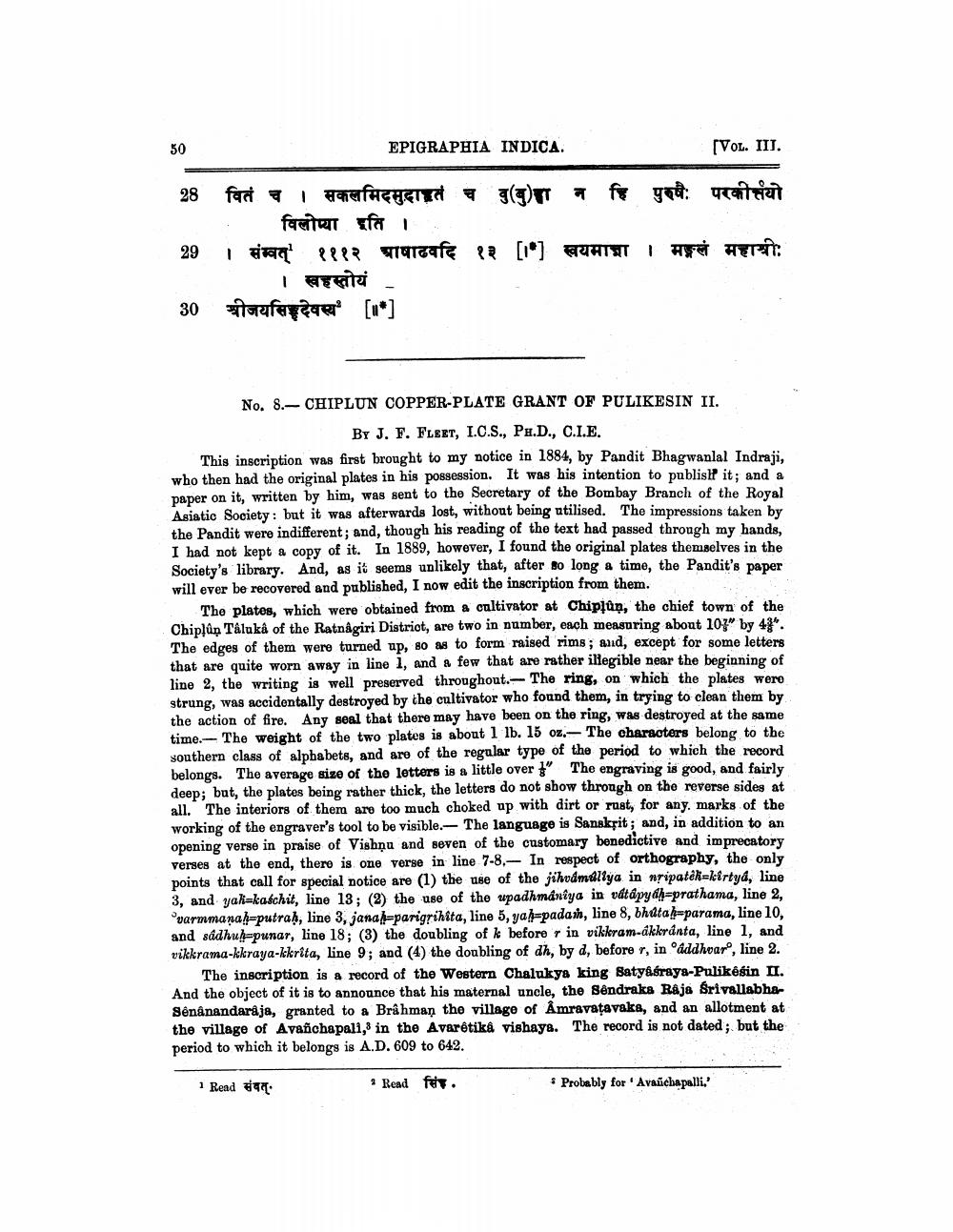________________
EPIGRAPHIA INDICA.
(VOL. III.
28 वितं च । सकलमिदमुदाहतं च (बुहा न हि पुरुषैः परकीयो
fasta fal 29 ian peep watcafe PR [") UHTET I HF Herit:
I acuiti 30 referee [0]
No. 8.- CHIPLUN COPPER-PLATE GRANT OF PULIKESIN II.
BY J. F. FLEET, I.C.S., Ph.D., C.I.E. This inscription was first brought to my notice in 1884, by Pandit Bhagwanlal Indraji, who then had the original plates in his possession. It was his intention to publish it; and a paper on it, written by him, was sent to the Secretary of the Bombay Branch of the Royal Asiatic Society: but it was afterwards lost, without being utilised. The impressions taken by the Pandit were indifferent; and, though his reading of the text had passed through my hands, I had not kept a copy of it. In 1889, however, I found the original plates themselves in the Society's library. And, as it seems unlikely that, after so long a time, the Pandit's paper will ever be recovered and published, I now edit the inscription from them.
The platos, which were obtained from a cultivator at Chiplun, the chief town of the Chiplun Täluka of the Ratnagiri District, are two in number, each measuring about 10%" by 43". The edges of them were turned up, so as to form raised rims; and, except for some letters that are quite worn away in line 1, and a few that are rather illegible near the beginning of line 2, the writing is well preserved throughout. The ring, on which the plates were strung, was accidentally destroyed by the cultivator who found them, in trying to clean them by the action of fire. Any seal that there may have been on the ring, was destroyed at the same time. The weight of the two plates is about 1 lb. 15 oz.-The characters belong to the southern class of alphabets, and are of the regular type of the period to which the record belongs. The average size of the letters is a little over ' The engraving is good, and fairly deep; but, the plates being rather thick, the letters do not show through on the reverse sides at all. The interiors of them are too much choked up with dirt or rust, for any marks of the working of the engraver's tool to be visible. The language is Sanskrit ; and, in addition to an opening verse in praise of Vishnu and seven of the customary benedictive and imprecatory verses at the end, there is one verse in line 7-8. - In respect of orthography, the only points that call for special notice are (1) the use of the jihvdmdliya in nripatêk=kirtyd, line 3, and yah-kalchit, line 13; (2) the use of the upadhmaniya in vdtápy dh prathama, line 2 Ovarmmanah-putrah, line 3, janal-parigrihita, line 5, yah-padan, line 8, bhdtah-parama, line 10, and sådhuh-punar, line 18; (3) the doubling of k before r in vikkram-akkránta, line 1, and vikkrama-kkraya-kkrita, line 9; and (4) the doubling of dh, by d, before r, in addhuar", line 2.
The inscription is a record of the Western Chalukya king Batyasraya-Pulikesin II. And the object of it is to announce that his maternal uncle, the Sendraks Raja SrivallabhaSénânandaraja, granted to a Brâhman the village of Amravatavaks, and an allotment at the village of Avañchapall,in the Avarêtika vishays. The record is not dated; but the period to which it belongs is A.D. 609 to 642.
1 Read संवत्
* Read
fer.
. Probably for 'Avauchapalli."




